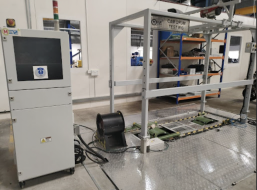CAM Drum Test / Bump Test
A CAM Drum test or Bump Test setup incorporates cams of various shapes and sizes to recreate the dynamics of driving in different conditions. Discover the industry standard in wear and fatigue testing with our advanced Cam Drum technology and setup for EV 2W.

During a bump test, an EV is subjected to controlled impacts or shocks that simulate real-world driving scenarios such as driving over potholes, speed bumps, or uneven road surfaces using cam profiles.
The bump test for Electric Vehicles (EVs) is a crucial evaluation method designed to assess the structural integrity, durability and robustness of vehicle chassis, shock absorber and suspension system, with the components and associated weight housed in the vehicle.
The impacts from uneven road surfaces can generate significant forces that may affect the stability and integrity of the vehicle’s components, especially the sensitive battery system.
Current Challenges in the Ecosystem
Electric Vehicles (EVs) face unique challenges related to the integration and durability of the design, structure and overall vehicle architecture. The substantial weight of EV battery packs necessitates reinforced chassis and suspension systems, which can impact vehicle dynamics and efficiency. Moreover, the placement of heavy battery modules requires careful design to maintain optimal weight distribution and structural integrity during impacts.
Battery Integration and Weight Distribution
Crashworthiness and Safety
Range Anxiety and Battery Performance
Charging Infrastructure Compatibility
Structural Materials and Manufacturing Errors
Vehicle Architecture and Design Flexibility
How Can CAM Drum Solve the Above Challenges?
Electric Vehicle bump testing is an indispensable testing solution for automotive engineers and technicians. It ensures that vehicles comply with safety standards before they are marketed. This testing process identifies potential Challenges/limitation with a vehicle’s suspension, braking system, wheels and tires, and other components before they pose safety risks.
Regular bump tests allow manufacturers to confirm that their vehicles are both safe and dependable for consumers. CAM Drum testing helps in identifying potential weaknesses in a product’s design, material, and overall vehicle durability.
Detects mechanical faults
Measures ride comfort
Evaluates wheel durability and tire performance
Verifies braking system robustness
Features of our CAM Drum System
Bump testing for electric vehicles is a fundamental aspect of the safety assurance process. The test rig is set up in a way that verifies the vehicle’s ability to manage bumps and other road irregularities safely and effectively.

Designed for Efficiency and Accuracy
Advanced Roller System
Precise Data Acquisition
Customizable Testing Modes
Varied Cam Profiles
Cooling Fans to Maintain Heat Dissipation
Designed for Efficiency
and Accuracy
Advanced Roller
System
Precise Data
Acquisition
Customizable Testing
Modes
Varied Cam
Profiles
Cooling Fans to Maintain
Heat Dissipation
CAM Drum Technical Specifications

|
RPM (Range)
|
15 Kmph Max - 50 Kmph
|
|
Total Load On Rollers
|
350Kgs
|
|
CAM Profile
|
A. Half Sine B. Trapezoidal C. Rectangle D. Triangle
|
FAQs
CAM Drum testing equipment is versatile and can be used to test a wide range of vehicles. At our facility, we provide testing for all types of 2 wheelers. This adaptability makes it ideal for analyzing durability across various vehicle types and components.
The price is decided on a project basis after understanding your testing requirements and overall validation objectives. To know more, please get in touch with us at [email protected].